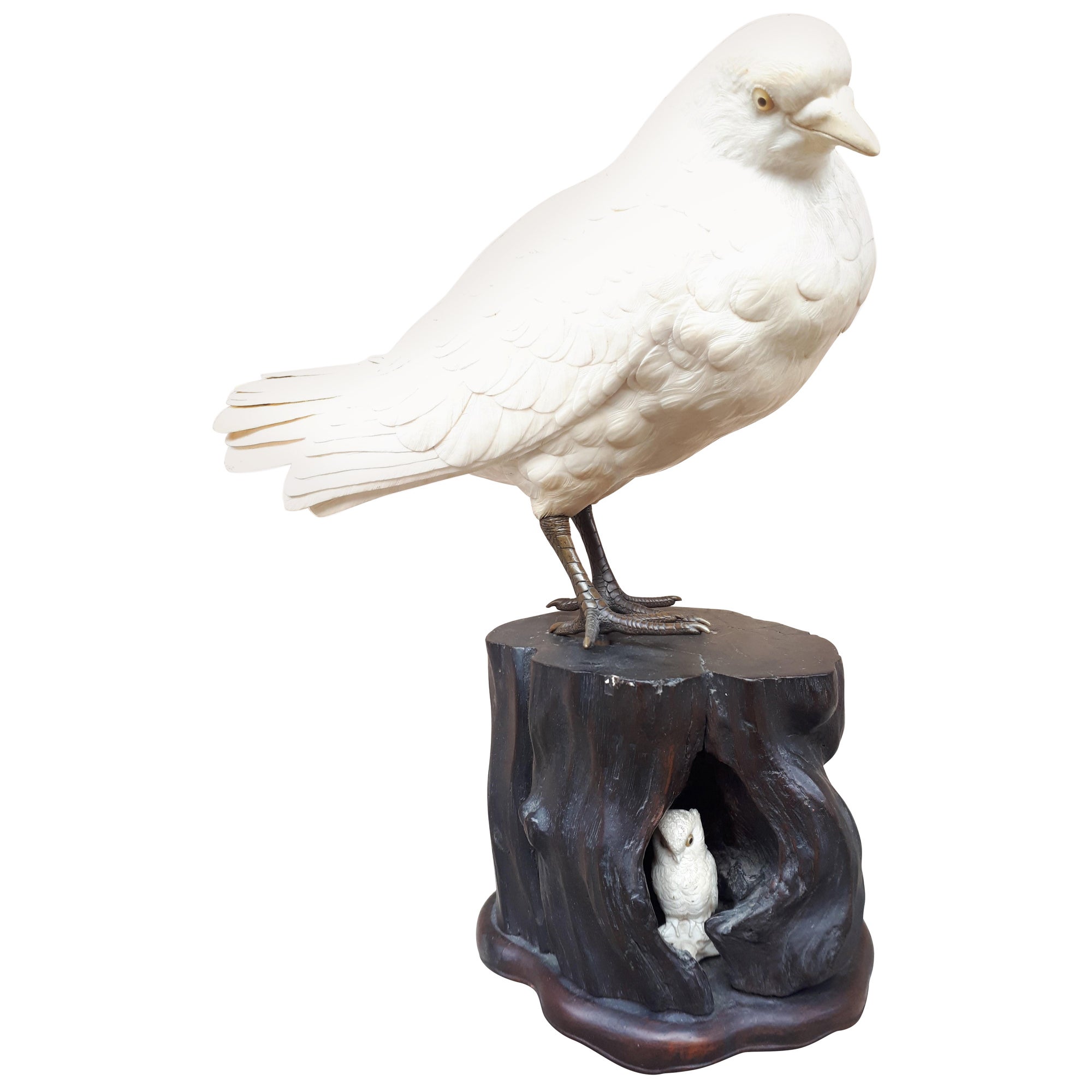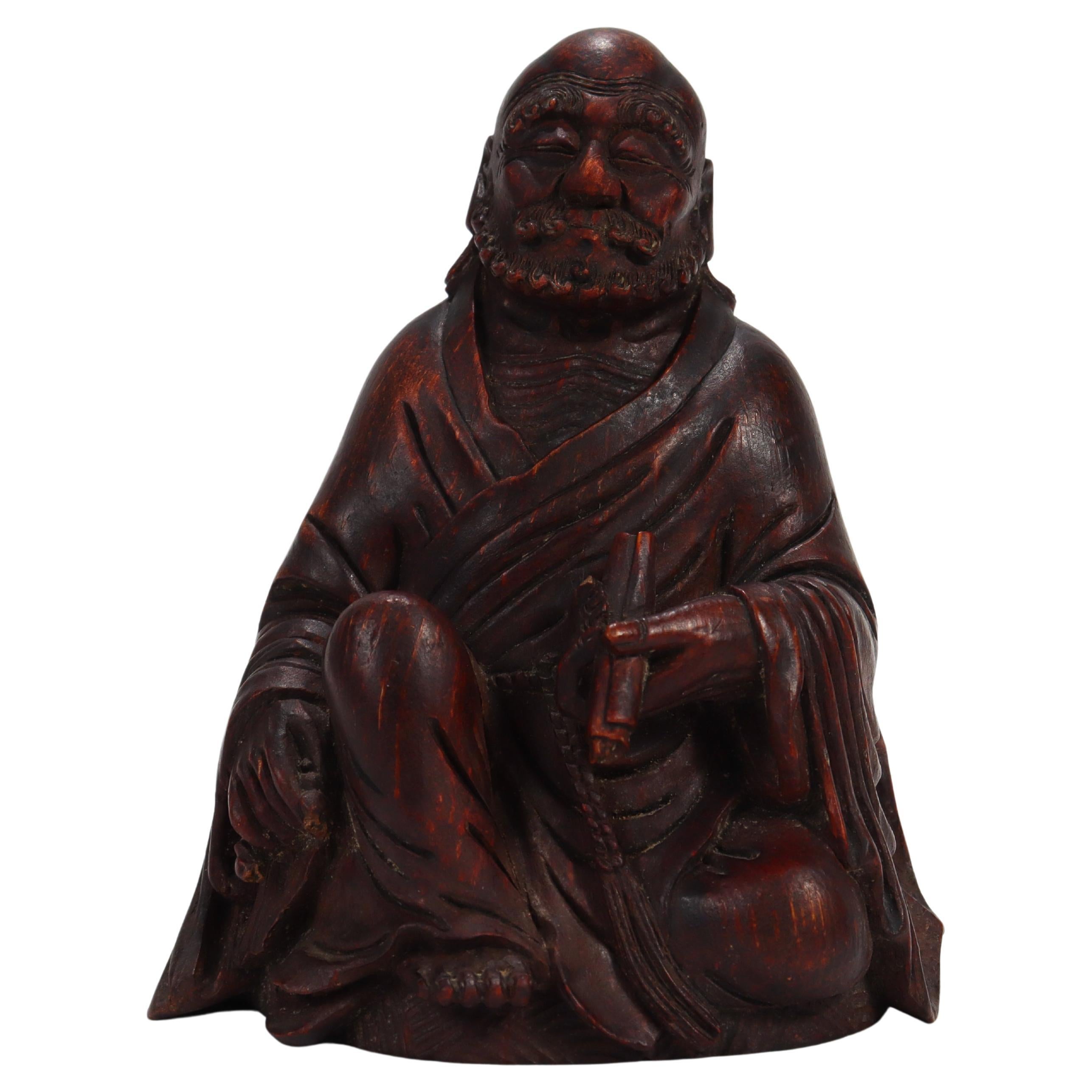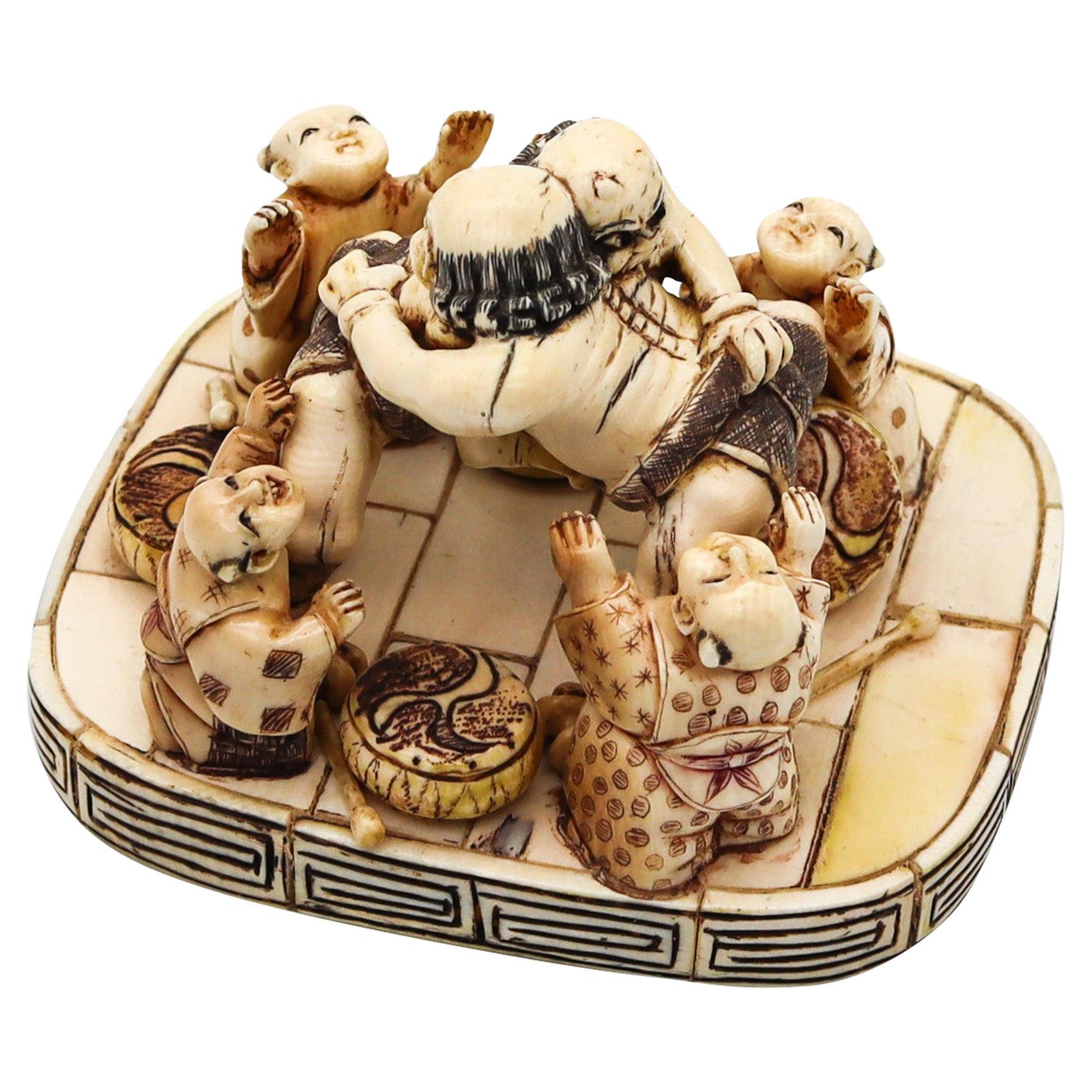Items Similar to Okimono Set of Carved Red Apple-Shapped Ivory Figurines with a Wooden Brown Base
Want more images or videos?
Request additional images or videos from the seller
1 of 7
Okimono Set of Carved Red Apple-Shapped Ivory Figurines with a Wooden Brown Base
About the Item
Okimono set of japanese hand-crafted and hand-carved figurines, in the shape of a pair of realistic red apples showing seeds and stem, made of ivory with a detached brown wooden base
By: unknown
Materials: ivory, wood
Technique: carved, hand-carved, hand-crafted
Date: late 19th century
Style: Meiji
Place of origin: Japan
Ivory has been used since the earliest times as a material for sculpture of small items, both in Europe and the east, principally China and Japan, where It is believed that it was already used in the 8th century. However, craftwork using ivory is said to have become common in Japan around the 17th century.
Okimono is a Japanese term meaning "ornament for display; objet d'art; decorative object", typically displayed in a tokonoma alcove or butsudan altar. They became popular during the Meiji period (1868 - 1912), when many okimono were made for export to the West. An okimono may be a small japanese carving, normally not larger than a few centimeters, purely decorative, and can be made out of wood, ivory, ceramic or metal. They depict all sorts of animals, mythological beasts, humans, gods, fruits, vegetables and objects, sometimes combined with each other, in a variety of positions.
In this case, we have a set of two hand-carved and hand-painted okimono. They represent two apples, where each one is meticulously carved from ivory and depicts the characteristic form and texture of the fruit in realism. Subtle details like the apple seeds and stems are portrayed with precision. The pair can be joined by a clasp to create one unified sculpture, so they can sit on a hand-carved, varnished wooden base.
Subtle discolorations can be observed on the surface of the apples, as well as some marks related to the passing of time and use, as evidenced in the photos.
- Dimensions:Height: 3 in (7.62 cm)Width: 5 in (12.7 cm)Depth: 4.5 in (11.43 cm)
- Sold As:Set of 2
- Style:Meiji (Of the Period)
- Materials and Techniques:
- Place of Origin:
- Period:
- Date of Manufacture:Late 19th Century
- Condition:Wear consistent with age and use. Subtle discolorations can be observed on the surface of the apples, as well as some marks related to the passing of time and use, as evidenced in the photos.
- Seller Location:North Miami, FL
- Reference Number:1stDibs: LU8678235544892
About the Seller
5.0
Gold Seller
These expertly vetted sellers are highly rated and consistently exceed customer expectations.
Established in 2011
1stDibs seller since 2023
24 sales on 1stDibs
Typical response time: <1 hour
- ShippingRetrieving quote...Ships From: Buenos Aires, Argentina
- Return PolicyA return for this item may be initiated within 10 days of delivery.
More From This SellerView All
- Late 18th Century/Edo-Meiji Period Japanese Glazed Porcelain Sculpture of a DogLocated in North Miami, FLLate 18th century/Edo-Meiji period japanese glazed porcelain sculpture of a dog By: unknown Material: porcelain Technique: molded, pressed, glazed Dimensions: 5.5 in x 7.5 in x 5 Da...Category
Antique Late 18th Century Japanese Edo Sculptures and Carvings
MaterialsPorcelain
- Art Déco English Square Shapped Cut Glass/Crystal Inkwell with Brass/Bronze TopLocated in North Miami, FLArt Déco english square shapped cut crystal inkwell with brass/bronze spherical top By: unknown Material: brass, bronze, cut glass, glass, metal, crystal, copper, zinc Technique: ca...Category
Early 20th Century English Art Deco Inkwells
MaterialsCrystal, Metal, Brass, Bronze, Copper, Zinc
- 20th C. English Set of Guilloche Enamel Perfume Glass Bottles with Silver BaseLocated in North Miami, FLEarly 20th century english set of guilloche enamel perfume glass bottles with silver base By: unknown Material: cut glass, enamel, glass, metal, silve...Category
Early 20th Century English Edwardian Bottles
MaterialsMetal, Enamel, Sterling Silver, Silver Plate, Silver
- Set of French Art Déco Zamac Winged Cherub/Fairy Child Bookends with Marble BaseLocated in North Miami, FLSet of early 20th century french Art Déco zamac winged cherub/fairy child bookends with marble base By: unknown Material: aluminum, bronze, marble, metal, zinc, copper Technique: ca...Category
Early 20th Century French Art Deco Bookends
MaterialsMarble, Copper, Metal, Zinc, Bronze, Aluminum
- Art Déco Enameled Porcelain Owl-Shapped Perfume Lamp by German Company AerozonBy AerozonLocated in North Miami, FLArt Déco enameled porcelain owl-shapped perfume lamp manufactured by german company Aerozon By: Aerozon Material: porcelain, ceramic, enamel, paint Technique: molded, pressed, ename...Category
Mid-20th Century German Art Deco Table Lamps
MaterialsEnamel
- Art Déco Édouard Marcel Sandoz's Porcelain Fox-Shapped Box for Theodore HavilandBy Theodore Haviland, Edouard-Marcel SandozLocated in North Miami, FLArt Déco painted enameled porcelain cat-shapped box by Édouard Marcel Sandoz for Theodore Haviland By: Édouard Marcel Sandoz, Theodore Haviland Material: ceramic, porcelain, paint, ...Category
20th Century French Art Deco Decorative Boxes
MaterialsEnamel
You May Also Like
- Ivory Okimono by Kofu, Japan Meiji eraLocated in Saverne, Grand EstRare okimono carved in the thickness of an elephant tusk depicting a life-size pigeon. It stands on a hollow trunk, inside which hides an owl. A small 4mm...Category
Antique 1880s Japanese Meiji Sculptures and Carvings
MaterialsIvory
- Japanese Meiji Period Carved Wood Okimono Man with RabbitsLocated in Newark, EnglandThe charming figure, carved from a single piece of wood is exceptionally carved showing the male figure with humorous expression holding two Rabbits one by the ears and the second under his arm. A third Rabbit stands at the feet of the male looking up, each rabbit with a different expression. The male figure is wearing traditional Japanese attire with his hair tied back stood upon a naturalistic base. The figure dates to the Meiji Period (1868-1912) circa 1900. Notes The Rabbit is one of the 12 animals to feature in the Japanese Zodiac signs which follows the Chinese astrological system along with the Rat, Ox, Tiger, Rabbit, Dragon, Snake, Horse, Goat, Monkey, Rooster, Dog, Pig. Such division is connected with the Jupiter cycle around the Sun, which lasts about 12 years. As 2023 is the year of the Rabbit...Category
Antique Early 1900s Japanese Meiji Sculptures and Carvings
MaterialsWood
- Finely Carved Japanese Okimono on StandLocated in Atlanta, GAAn antique Okimono (Japanese means artsy display ornament object) displayed on a small custom wood stand from Meiji Period circa early 2oth century. T...Category
Early 20th Century Japanese Japonisme Sculptures and Carvings
MaterialsWood
- Old or Antique Japanese Wooden Figurine of a Buddhist MonkLocated in Philadelphia, PAA Japanese wooden figurine of a Buddhist monk. In the form of a seated Buddhist monk. He holds a scroll in his left hand, and a mala/juzu (rosary) i...Category
Early 20th Century Japanese Meiji Sculptures and Carvings
MaterialsWood
- Japan 1900 Meiji Period Rare Carved Okimono of Two Sumo Fighters SignedLocated in Miami, FLJapanese Okimono sculpture of a father and son. A highly detailed sculptural composition, created during the Meiji imperial period (1868-1912), circa 1900. The composition displayed...Category
Antique 1890s Japanese Meiji Sculptures and Carvings
MaterialsIvory
- Japan 1890 Meiji Period Rare Carved Okimono Of A Father And Son Playing SignedLocated in Miami, FLJapanese Okimono sculpture of a father and son. Very rare and highly detailed sculpture, created during the meiji period (1868-1912) in the imperial Japan, circa 1890. This sculptural Okimono is very well realized and exceptionally proportionate. Show the figures of a father and a son playing, with happiness and smiling. The father hold a big basket at his back and both personages are wearing kimonos richly engraved. This piece was made from a carving with exceptional craftsmanship and intricate details. This sculpture stand itself on his own base and have all retain of the applied ochre ink accents. Measures: 130 mm by 45 mm by 53.3 mm (5.1 x 1.75 x 2.1 inches). Weight: 81.30 grams. Note: This kind of family scene is very rare to seen in nineteenth century japanese iconography. Okimono Is a Japanese term meaning for display an ornament; art object; or decorative object, usually displayed in a tokonoma or butsudan "Buddhist altar". It is an ornament or figure, especially one placed in a guest room. An okimono may be a small Japanese carving, similar to but larger than a netsuke. Unlike the netsuke, which had a specific purpose, the okimono is exclusively decorative and was displayed in the tokonoma. During the Meiji period, many okimonos were made for export to the West. Meiji Period This is an era of Japanese history that extended from October 23, 1868 to July 30, 1912.The Meiji era was the first half of the Empire of Japan, when the Japanese people moved from being an isolated feudal society at risk of colonization by Western powers to the new paradigm of a modern, industrialized nation state and emergent great power, influenced by Western scientific, technological, philosophical, political, legal, and aesthetic ideas. As a result of such wholesale adoption of radically different ideas, the changes to Japan were profound, and affected its social structure, internal politics, economy, military, and foreign relations...Category
Antique 1890s Japanese Meiji Sculptures and Carvings
MaterialsWood, Paint





